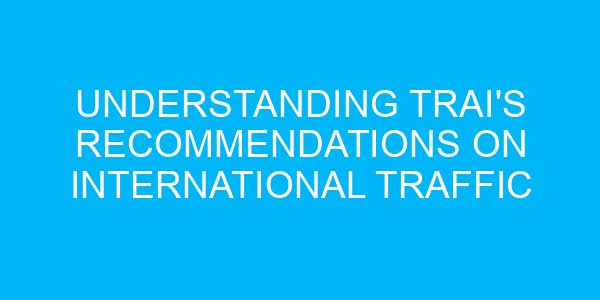The Telecom Regulatory Authority of India (TRAI) recently released its recommendations on the definition of International Traffic. These recommendations aim to address ambiguities in the transmission of SMS traffic on domestic and international routes. Understanding these developments is crucial for students preparing for competitive exams, particularly those focused on governance, telecommunications, and regulatory frameworks in India. This article provides a concise explanation of TRAI’s recommendations, their background, and their significance in India’s booming telecommunication sector.
What Is International Traffic?
TRAI has recommended defining International Traffic as any telecommunication traffic originating in one country and terminating in another, where one of the countries is India. This definition extends to SMS messages, with distinctions made between international and domestic SMS traffic for clarity within telecommunication service licenses.
Key Definitions Proposed by TRAI:
- International SMS Message: Defined as international traffic delivered using SMS.
- Domestic Traffic: Traffic originating and terminating within India.
- Domestic SMS Message: Defined as domestic traffic delivered using SMS.
Why Were These Recommendations Necessary?
In 2021, TRAI received conflicting requests from entities regarding the routing of SMS traffic:
- One entity sought permission to transmit its SMS traffic through the domestic route.
- Another entity requested clarification for routing transactional messages domestically instead of internationally.
This prompted TRAI to consult the Department of Telecommunications (DoT). However, DoT found no explicit definitions for Domestic and International SMS in existing License Agreements or TRAI regulations, which necessitated the issuance of these recommendations.
Existing Challenges Highlighted:
- Regulated vs. Forbearance Charges: While termination charges on domestic SMS are regulated, those on international SMS are not. This led to confusion over the categorization of messages.
- Lack of Clarity in Agreements: Telecommunication License Agreements lacked definitions for domestic and international SMS traffic.
TRAI’s Approach to Address the Issue
TRAI formulated its recommendations based on inputs from stakeholders during an open house discussion and its own analysis. By defining these terms, TRAI aims to remove ambiguity and ensure uniform treatment of telecommunication traffic.
Specific Recommendations:
- Any Application to Person (A2P) SMS message incoming to India will be classified as an international SMS if its transmission requires intervention from an electronic device, computer system, or application located outside India.
- Definitions of domestic and international traffic must be explicitly included in telecommunication service licenses.
India’s Telecommunication Landscape
India is the world’s second-largest telecommunication services market, with 1,163.83 million wireless subscribers and 36.23 million wireline subscribers as of August 2024. Over the last two decades, India has witnessed unparalleled growth in this sector, making regulatory clarity essential for sustaining progress.
Key Takeaways for Competitive Exam Aspirants
- Clarity in Definitions: TRAI’s recommendations aim to standardize the treatment of SMS traffic, distinguishing between domestic and international routes. This aligns with the broader goals of regulatory transparency.
- Significance of Regulations: Understanding the roles of TRAI and DoT in resolving ambiguities provides insights into India’s regulatory ecosystem.
- Telecom Sector Growth: The data highlights India’s position as a global telecommunication leader, making this topic relevant for economics, governance, and general awareness sections in exams.
By familiarizing themselves with these recommendations, aspirants can better appreciate the dynamic interplay between policy-making and technological advancements in India’s telecommunication industry. This knowledge can serve as an edge in answering questions on current affairs, governance, or infrastructure in competitive exams.



